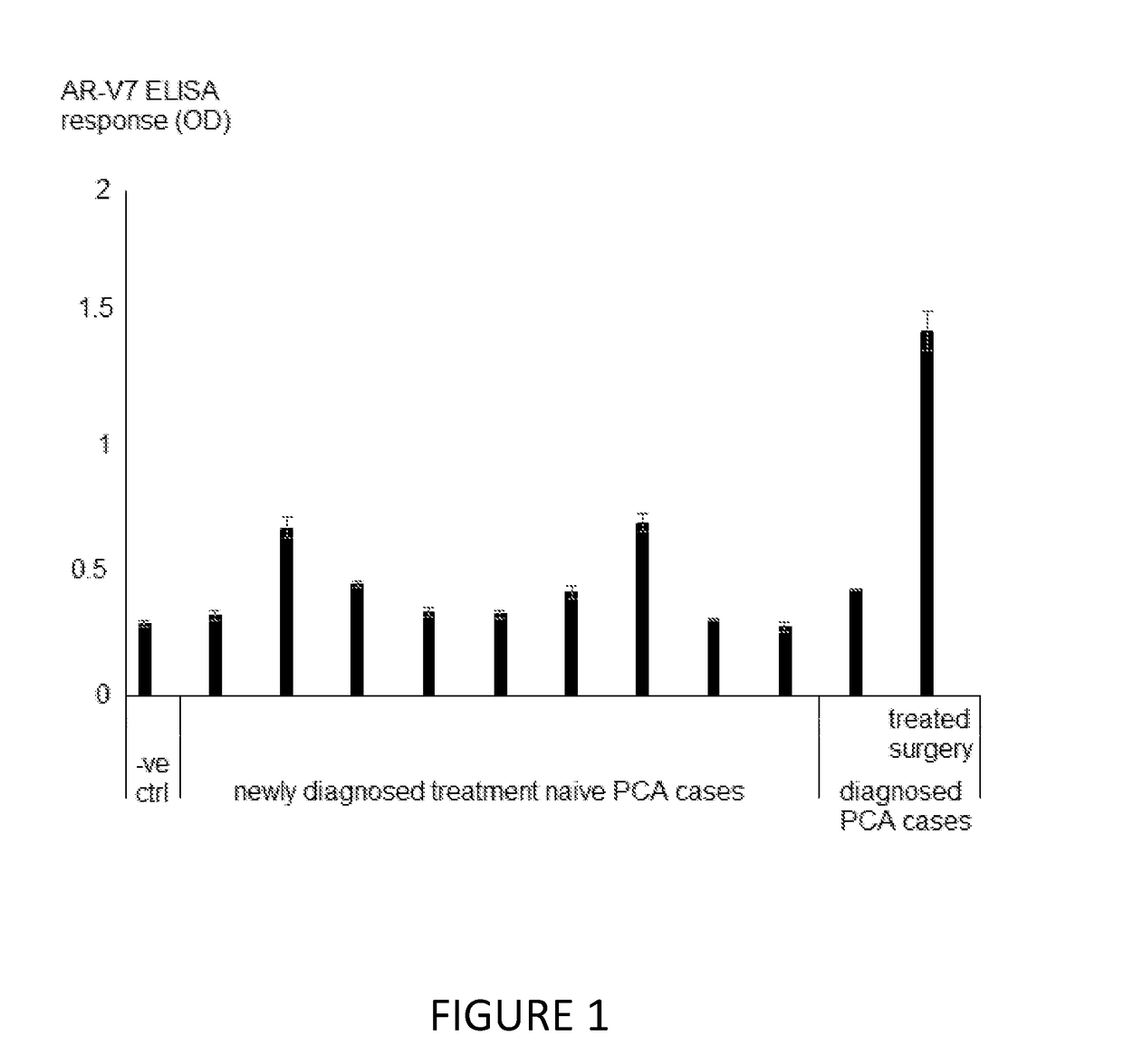Method for the detection of hormone sensitive disease progression
- Summary
- Abstract
- Description
- Claims
- Application Information
AI Technical Summary
Benefits of technology
Problems solved by technology
Method used
Image
Examples
example 1
[0080]Serum samples were taken from 9 treatment naïve subjects with newly diagnosed prostate cancer and 2 subjects who had been diagnosed within the previous six months. One of these two subjects was also treatment naïve and the other had advanced disease for which surgery was the selected treatment. Blood was drawn from this subject on the day of surgery. A horse serum sample was used as a negative control. The samples were tested for circulating cell free nucleosome bound AR-V7 by an ELISA method using a solid phase anti-histone capture antibody and a biotinylated anti-AR-V7 detection antibody as follows: Serum sample (10 μL / well) and assay buffer (50 μL / well), were added to microtitre plate wells and incubated overnight at 4° C. The serum and assay buffer mixture was decanted and the wells were washed three times with wash buffer. A solution of biotinylated anti-AR-V7 detection antibody was added (50 μL / well) and incubated for 90 minutes at room temperature with mild agitation. E...
example 2
[0081]Serum samples were taken from treatment naïve subjects with newly diagnosed breast cancer and from subjects with treated breast cancer. The samples were tested for circulating cell free nucleosome bound ERα-Δ5 by an ELISA method similar to that described in EXAMPLE 1 above but instead using a biotinylated anti-ERα-Δ5 detection antibody. Low ELISA signals were observed in the treatment naïve newly diagnosed breast cancer cases. The results indicated that there had been no development of ERα-Δ5 mediated hormone therapy resistance in these treatment naïve subjects. However, a high signal was observed for some of the subjects with treated breast cancer disease indicating elevated levels of circulating cell free nucleosome bound ERα-Δ5 variant adducts in the serum samples from those subjects and disease progression to a hormone therapy resistant breast cancer disease in those subjects.
example 3
[0082]Serum samples were taken from treatment naïve subjects with newly diagnosed breast cancer and from subjects with treated breast cancer. The samples were tested for circulating cell free nucleosome bound ERβ2 by an ELISA method similar to that described in EXAMPLE 1 above but instead using a biotinylated anti-ERβ2 detection antibody. Low ELISA signals were observed in the treatment naïve newly diagnosed breast cancer cases. The results indicated that there had been no development of ERβ2 mediated hormone therapy resistance in these treatment naïve subjects. However, a high signal was observed for some of the subjects with treated breast cancer disease indicating elevated levels of circulating cell free nucleosome bound ERβ2 variant adducts in the serum samples from those subjects and disease progression to a hormone therapy resistant breast cancer disease in those subjects.
PUM
 Login to View More
Login to View More Abstract
Description
Claims
Application Information
 Login to View More
Login to View More - R&D
- Intellectual Property
- Life Sciences
- Materials
- Tech Scout
- Unparalleled Data Quality
- Higher Quality Content
- 60% Fewer Hallucinations
Browse by: Latest US Patents, China's latest patents, Technical Efficacy Thesaurus, Application Domain, Technology Topic, Popular Technical Reports.
© 2025 PatSnap. All rights reserved.Legal|Privacy policy|Modern Slavery Act Transparency Statement|Sitemap|About US| Contact US: help@patsnap.com

